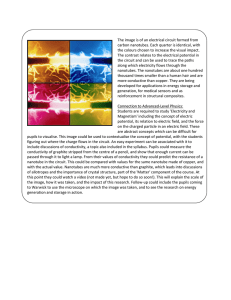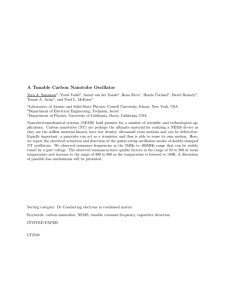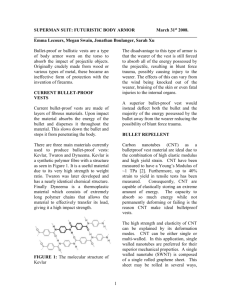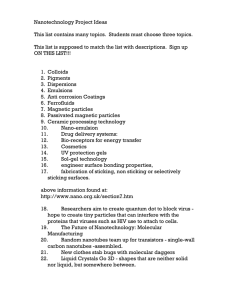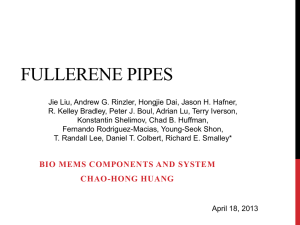Presentation
advertisement
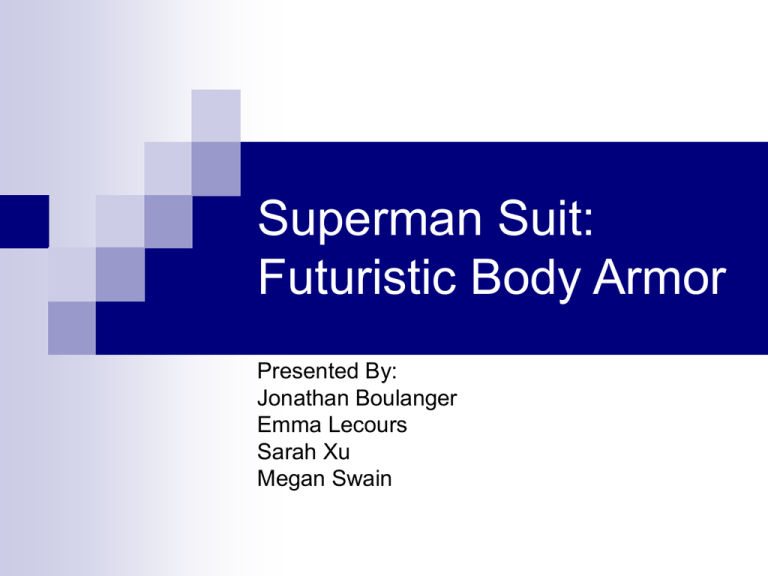
Superman Suit: Futuristic Body Armor Presented By: Jonathan Boulanger Emma Lecours Sarah Xu Megan Swain Outline Current bulletproof vests Why put carbon nanotubes in bulletproof vests? Experimental testing Extension to macroscopic Conclusion Current Bullet-Proof Vests • Made of layered fibrous material • Absorbs and disperses the energy of the projectile • Slows and stops the bullet Current Materials • Kevlar • Many strong bonds between chains • Twaron • nearly identical chemical structure to Kevlar • Dyneema (Ultra high molecular weight polyethylene) • extremely long polymer chains (n>100 000) • load transferred to polymer backbone Problems with Current Bullet-Proof Vests • Wearer is forced to absorb the energy of the projectile • Blunt force trauma can occur • wind knocked out of the wearer • bruising of the skin • injuries to the internal organs (possibly fatal) • Superior vest would deflect the energy of the bullet away from the wearer Why Carbon Nanotubes? High modulus of elasticity (~1 TPa) High strain to yield (up to 40% in tensile) Multiple deformation modes: Elongation of hexagonal structure High defect mobility of 5-7 ring defects Stepwise diameter reduction Tube collapse Necking Carbon Nanotube Deformation [2] Experimental Procedure Computer simulation to model nanotube deformation Uses Tersoff-Brenner potential Diamond bullet Maximum absorption energy Highest in center of fixed end CNT Does not vary significantly with radius Varies linearly with length of nanotube Absorption Energy Bounce back time the same Needs 12.5ps to ‘recover’ Extension to Macroscopic Applications •Variations in atomic structure of CNTs with same diameters only depend on their different lengths. •Macroscopic response can be approximated from microscopic calculations. •A revolver bullet typically has a damage area of 0.652 cm^2 and energy of 320J. •If a bundle (yarn) has a 100 μm diameter (5 X 10^9 nanotubes ), it should be able to absorb 0.344J. •Therefore 6 layers of woven fabric composed of 180 nanotube yarns (0.9cm) will be sufficient, which corresponds to a thickness of 600 μm Conclusions Carbon nanotubes have great potential Large capacity to store elastic energy without deforming Repeated impacts possible (12.5 ps limit) Only computer simulations so far According to assumptions, will scale well into the macroscale If assumptions hold, 600 μm woven CNT yarns will be sufficient to repel bullets References 1. 2. Ajayan, P. M. (1999). Nanotubes from carbon. Chemical Reviews, 99(7), 1787. Mylvaganam, K., & Zhang, L. C. (2007). Ballistic resistance capacity of carbon nanotubes. Nanotechnology, 18(47), 475701. Questions?


